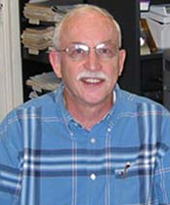Thomas Roche, Ph.D., University Distinguished Professor Emeritus

Contact informationE-mail: bchter@ksu.edu EducationB.S. 1966, Regis College |
Areas of specialty
- Structure, function and regulation of mammalian pyruvate dehydrogenase complex
In a full context of the structure, function, and interactions of the components of the pyruvate dehydrogenase complex (PDC), our research seeks to elucidate the short-term regulation of the mammalian PDC. The primary target is understanding the structure, molecular interactions and effector control of the pyruvate dehydrogenase kinase (PDK) and pyruvate dehydrogenase phosphatase (PDP) isoforms. PDKs phosphorylate and inactivates the E1 (pyruvate dehydrogenase) component and PDPs dephosphorylate and reactivate E1. Differences in the operation and the effector responsiveness of the kinase and phosphatase isoforms are dependent upon differences in the functional interplay of the 4 PDK isoforms and 2 PDP isoforms with the dihydrolipoyl acetyltransferase (E2) component and E3-binding protein (E3BP). To alter kinase and phosphatase function and regulation, E2 serves as an anchoring scaffold, as an adaptor protein directly aiding efficient phosphorylation and dephosphorylation, as a processing unit in translating effector signals, and as a direct allosteric agent in consequentially altering regulatory enzyme activities. We have uncovered these roles, as well as an adaptor role of E3BP in the case of one PDK isoform, and seek to learn the molecular basis by which these occur. Our efforts are aided by advances that we have made in developing E. coli expression systems for making most components (E1, E2, E2-E3BP, E3, 4 PDKs, catalytic subunit of PDP1) and a large number of E2 constructs. We use a combination of standard enzymology, molecular biology, and biophysical techniques.
Selected publications
Guo, Y., Qiu, W., Roche, T.E., Hackert, M.L. (2020) Crystal structure of the catalytic subunit of bovine pyruvate dehydrogenase phosphatase. Acta Crystallogr. F Struct. Biol. Commun. 76, 292-301. With online Supplemental Information.
Jiang, J., Baiesc, F.L., Hiromasa, Y., Yu, X., Hui, W.H., Dai, X., Roche, T.E., Zhou, Z.H. (2018) Atomic Structure of the E2 Inner Core of Human Pyruvate Dehydrogenase Complex. Biochemistry 57, 2325-2334.
Hiromasa, Y., Yan, X., and Roche, T. E. (2008) Specific ion influences on self-association of pyruvate dehydrogenase kinase isoform 2 (PDHK2) binding of PDHK2 to the L2 lipoyl domain, and effects of the lipoyl group-binding site inhibitor, Nov3r. Biochemistry 47:2312-2324.
Hiromasa, Y. and Roche, T. E. (2008) Critical role of specific ions for ligand-induced changes regulating pyruvate dehydrogenase kinase isoform 2. Biochemistry 47:2298-2311.
Yu, X., Hiromasa, Y., Tsen, H., Chiu, W., Stoops, J. K., Roche, T. E., and Zhou, Z. H. (2008) Structures of the human pyruvate dehydrogenase complex cores: a highly conserved catalytic center with flexible N-terminal domains. Structure 16:104-114.
Roche, T. E. and Hiromasa, Y. (2007) Pyruvate dehydrogenase kinase regulatory mechanisms and inhibition in treating diabetes, heart ischemia, and cancer. Cell. and Mol. Life Sci. 64:830-849.
Knoechel, T. R., Tucker, A. D., Robinson, C. M., Phillips, C., Taylor, W., Bungay, P. J., Kasten, S. A., Roche, T. E., and Brown, D. G. (2006) Regulatory roles of the N-terminal domain based on crystal structures of human pyruvate dehydrogenase kinase 2 containing physiological and synthetic ligands. Biochemistry 45:402-415.
Hiromasa, Y., Hu, L., and Roche, T. E. (2006) Ligand-induced Effects on Pyruvate Dehydrogenase Kinase Isoform 2. J. Biol. Chem. 281:12568-12579.